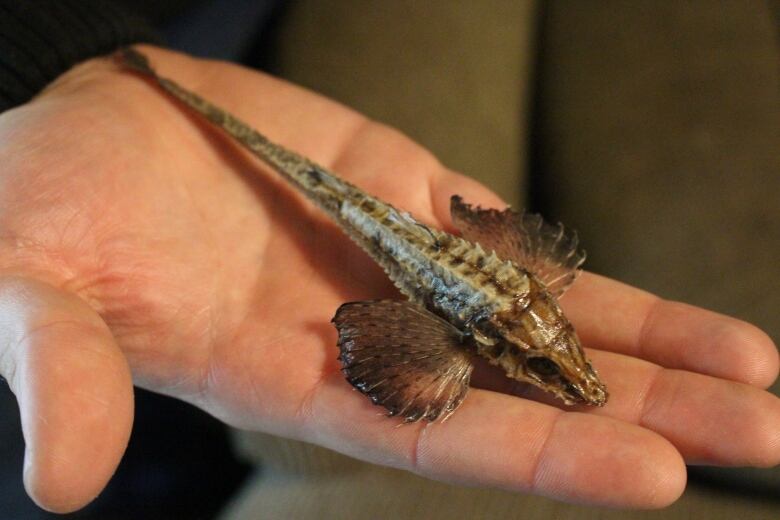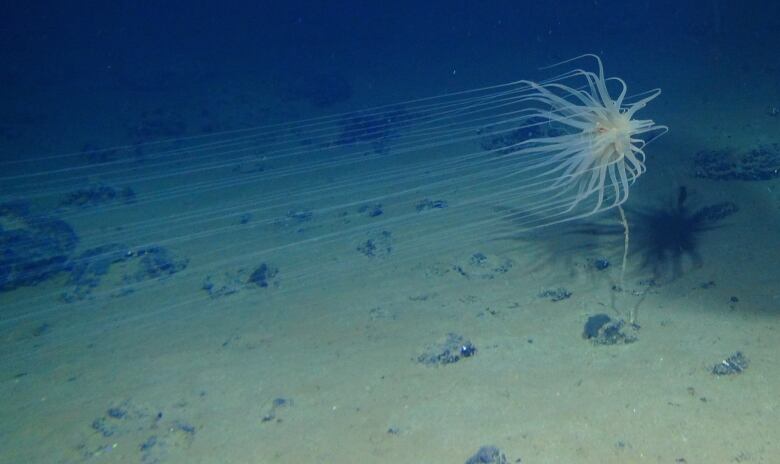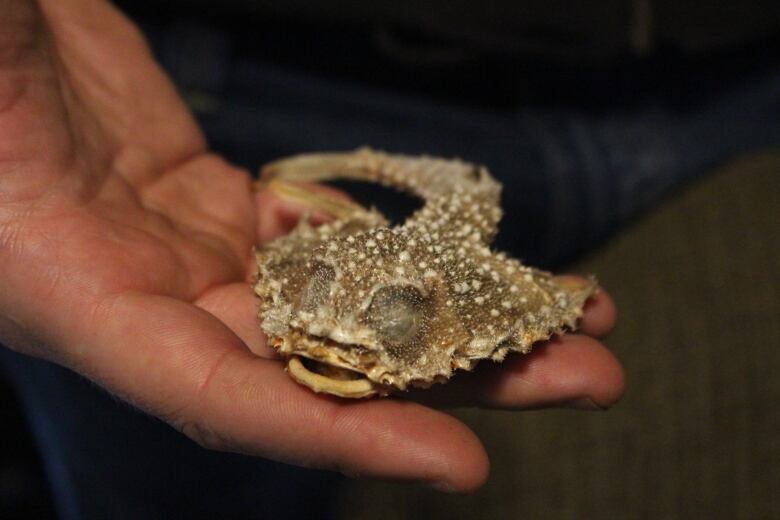Meet the Nova Scotian couple preserving the ocean's mysteries through taxidermy
Stephan Bakir and Savanna Schnare have carved out a niche by focusing on marine species

In Stephan Bakir and Savanna Schnare's kitchen, a tray filled with some unusual contents sits on top of their stove.
The baking sheet carries the heads of lancetfish large-eyed deep-sea dwellers, with curved, interlocking fangs that are being prepared for freeze drying.
"There's a long-nose lancet and a short-nose lancet, which is theoretically the only two species in the world. But the reason we're getting them is we think we might have found a third species."
Bakir and Schanre plan to freeze dry these specimens to compare them against future specimens they receive, to see if their hunch about a local subspecies of lancetfish is correct.
The couple who operate ataxidermy business under the name Straight from the Schnare say it's part of a practice that they hope will boost our understanding of marine biology,echoing a broader push by researchers to better understand ocean species as the climate changes.

For both Bakir and Schnare, the interest in taxidermy stretches back a long way.
Bakir got into taxidermy as a teenager, after volunteering at a museum that was trying to preserve some of its rare living animals, as they passed away.
"It was a means of trying to preserve what we had as opposed to losing it forever," he says.
For Schnare, a longstanding love of animalsturned into a profession after a neighbour suggested there was work to be had due to a shortage of skilled taxidermists.
Eventually the couple met via an exchange of flesh-eating beetles,whichhelp clean the flesh of bones. (Schnare needed them for a projectandBakir, who was in Ontario at the time,was one of the only sources.)
Aftersetting up shopin Nova Scotia, theycame to focus on marine species. This meant navigating both the bureaucratic hurdles of obtaining permits from DFO and the Canadian Wildlife Service, and the technical challenges involved in preserving the delicate bodies of skeletons of deep-sea creatures like the lancetfish or Sloan's viperfish.

But the couple persisted, and now operate a successfultaxidermy business out of their home near Shelburne, selling specimens to private collectors and institutions. This focus was partly an attempt tocarve out a niche compared to other taxidermists, and to explore the mysteries the ocean holds.
"There's a lot of room for finding new stuff," says Bakir. "Like, we have a sea poacherin the truck that we can't identify. I don't think it is a known species."A sea poacher is a small, bottom dwelling fish with a long tail and wing-like fins.
Bakir and Schnare aren't alone in this. Across the world, scientists estimate that only a tenth of all species have been described
That makes documenting species all the more important as a way of determining how species are declining, or moving into new areas.
Work is happening at the global level to fill in the gaps, including the World Register of Marine Species (or WoRMS) which aims to complete a comprehensive list of marine species by 2030.

Another project, the Ocean Census, aims to identify 100,000 unknown species over the next decade.
Environment Canada says 50,000 species in Canada have been identified and given scientific names,including marine species, according to Jean-Marc Gagnon, chief scientist for the Canadian Museum of Nature. But experts believe that number could riseas high as 125,000, he noted.
While there are ways to do this work including using eDNA (a technology that can detect organisms by picking up the DNA they release into the environment) to sample areas for undiscovered species Gagnon says naming what's there is still an essential step, though it remains challenging in environments like the deep ocean.
"If I can't put a name on it, I can't call a government to do anything about it, to protect it and protect the habitat," he says.
With pressures on biodiversity increasing, from existing threats like climate change to new threats like deep-sea mining underscored by the recent discovery of 5,000 new species in a future mining site in the Pacific ocean Gagnon says efforts to understand biodiversity are increasingly important.
Nonetheless, he says progress has been slow; in 2010, a national report noted that Canada lacked the expertise to fully understand its biodiversity, and Gagnon says little has changed.
"I hope most of us realize that the planet is in a dire situation and we're not able to move fast enough to help it. So taxonomy is part of that, taxonomy is the basis of describing what's on this planet and it takes time and we're running out of time."

For their part, Bakir and Schnare hope to open their collection to public use, to help people understand the changes that are happening as environmental conditions and the distribution of speciesshift.
"We are trying to create a museum, or a specimen library for specimens local to here, because things that used to be fairly abundant just aren't anymore."
They are also hoping to expand access to marine species by donating specimens to Canadian high schools.
The couple already provide specimens to universities and other institutions, but hope to build interest among a younger generation by allowing them more direct contact with and appreciation for the creatures that live in the ocean.

"We sat in and gave a couple lectures at local colleges and universities. And it's all on a screen," Bakir says. "It's so much easier to learn when you can physically manipulate things."
"Not everyone is good with books like me," says Schanre. "But give them something tangible and that person could be amazing."
In Bakir and Schnare's kitchen, the lancetfish being prepared for freezing whose curved teeth suggest a fearsomedeep sea predator, but whose dried skeleton is more fragile than tissue paper on land serves as a reminder of the value of close observation andthe fragility of what's at stake.
"You'd think teeth like that, a predator, they'd be solid," says Bakir. "But surprisingly, they're like paper. Their bones are [like] paper, their skin is softer than paper. They're very very delicate animals."
MORE TOP STORIES












_(720p).jpg)


 OFFICIAL HD MUSIC VIDEO.jpg)
.jpg)



























































































